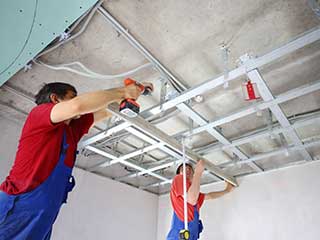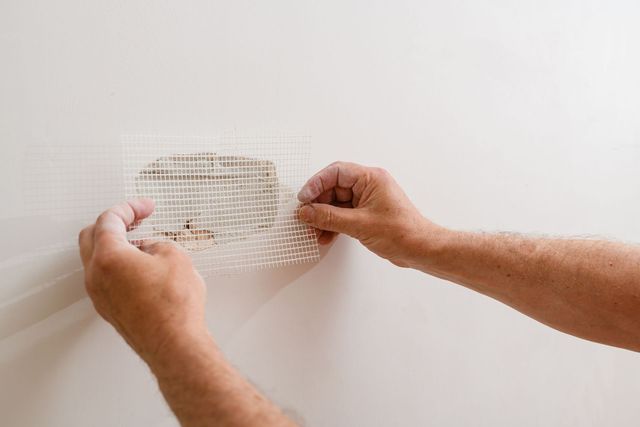Discover the Ideal Practices for Effective Drywall Repair and Installation
The art of drywall repair work and installment needs a blend of skill and precision. Understanding the vital devices is necessary for attaining a seamless coating. Understanding the detailed procedure can make a substantial difference in the outcome. Proper strategies for mudding and taping are likewise critical. What remains is the knowledge of maintenance that ensures long life. These elements with each other produce a sleek end result worth checking out even more.

Important Tools for Drywall Repair Work and Installation
When taking on drywall repair work and installment, having the right tools can substantially enhance the efficiency and top quality of the job. An utility blade is important for reducing drywall sheets exactly, while a drywall saw can help in making a lot more detailed cuts. Taping knives, offered in various dimensions, are important for applying joint compound smoothly and evenly. A drywall sander, ideally with a dust collection function, assists accomplish a polished surface, lowering the demand for extensive cleaning.
Furthermore, a measuring tape warranties precise measurements, and a level guarantees that installations are straight and plumb. Safety and security gear, including dust masks and goggles, must not be ignored to shield against debris and dust. A stud finder help in finding mounting members, assuring protected installment. By gearing up oneself with these essential tools, the repair service and installment procedure comes to be much more convenient and results in a professional-quality end result.

Step-by-Step Guide to Patching Holes
Covering holes in drywall requires a methodical approach to assure a smooth repair. First, the area around the opening must be cleaned up and any loose debris removed. For tiny holes, a putty blade can be utilized to apply a lightweight spackle, pressing it right into the opening and smoothing the surface area. After it dries out, sanding is important to produce a level surface. For bigger holes, a spot of drywall might be necessary. This entails reducing a piece of drywall a little larger than the hole, protecting it to the wall with screws, and making use of joint substance to cover the joints. When the compound dries out, it needs to be fined sand smooth. Keying the patched area prior to painting will certainly guarantee an also surface. Following these steps will certainly lead to a professional-looking repair service that mixes perfectly with the bordering wall surface.
Strategies for Seamless Drywall Installment
Accomplishing seamless drywall setup needs careful preparation and execution. First, it is necessary to measure and cut drywall sheets properly to reduce spaces. Making use of an utility knife, installers need to rack up the board prior to breaking it along the cut line, guaranteeing tidy sides. Correctly aligning the sheets is important; beginning with the top and working down assists keep uniformity.
Attaching drywall to the studs needs constant spacing, commonly every 16 inches, making use of screws as opposed to nails for far better hold. This approach minimizes the risk of stands out in time. Furthermore, startling the seams between sheets enhances structural stability and lowers the visibility of joints.
Finally, making use of the right thickness of drywall for particular areas-- such as moisture-resistant enters restrooms-- more adds to a remarkable coating. Adhering to these methods will certainly result in a professional-looking and smooth setup, establishing the stage for the subsequent ending up processes.
Ending Up Touches: Insulation and Mudding
Completing touches, such as taping and mudding, play an essential role in accomplishing a polished drywall surface area. Insulation includes using a slim strip of drywall tape over the joints and seams, making certain a seamless look. This process aids prevent splits and develops a solid bond between drywall sheets. It is important to select the ideal sort of tape, with paper and fiberglass fit together being the most typical choices.
Mudding, or using joint compound, adheres to insulation. This substance completes gaps and ravel the surface area for an uniform finish. It is generally used in several layers, with each coat needing to dry prior to fining sand. Proper technique includes feathering the sides to mix the substance right into the surrounding drywall, reducing presence.
When completed appropriately, mudding and taping boost both the visual and architectural stability of the drywall installation, causing a professional-quality surface.
Tips for Preserving Your Drywall After Setup

Additionally, maintaining a constant indoor moisture level can protect against warping or mold development. Using a dehumidifier in damp areas, like cellars, is suggested. It's also advantageous to periodically paint locations that show wear, as this secures the underlying material. When relocating website furniture or setting up components, caution needs to be worked out to avoid harming the drywall. By complying with these maintenance tips, property owners can prolong the life of their drywall, guarding it remains an appealing attribute of their insides.
Often Asked Inquiries
What Safety Equipment Is Essential for Drywall Fixing and Setup?
For drywall fixing and installation, necessary security gear includes safety and security goggles to protect eyes, dust masks to stop inhalation of fragments, handwear covers for hand protection, and knee pads for comfort during prolonged kneeling. Drywall Installation Ogden Utah.
Exactly how Do I Determine the Drywall Thickness Needed for My Project?
To establish the drywall density needed for a job, one ought to take into consideration the wall's architectural requirements, neighborhood building ordinance, and the planned use the area, generally selecting 5/8-inch or 1/2-inch drywall.
Can I Fix Drywall Without Removing Furnishings From the Area?
Yes, drywall can be fixed without eliminating furnishings from the space. Cautious preparation and protective measures can lessen mess, enabling reliable repairs while maintaining bordering products safe from dust and damages throughout the process.
What Types of Drywall Are Finest for Different Settings?
Moisture-resistant drywall is ideal for kitchen areas and washrooms, while soundproof drywall matches shared walls in apartments. Fire-rated drywall is best for garages, and common drywall works well as a whole living locations, making sure durability and viability for various environments.
For how long Does It Consider Drywall Mud to Dry Entirely?
Drywall mud generally takes 24 to two days to dry totally, relying on elements like moisture and temperature (Drywall Installation Ogden Utah). Thicker applications may require longer drying out times, while thinner layers can dry more swiftly. Proper air flow help drying
The art of drywall repair service and installation needs a mix of ability and precision. When taking on drywall fixing and installation, having the right devices can significantly enhance the performance and quality of the work. An utility knife is essential for reducing drywall sheets specifically, while a drywall saw can help in making a lot more elaborate cuts. Achieving smooth drywall installment needs cautious planning and execution. Moisture-resistant drywall is suitable for washrooms and kitchen areas, while soundproof drywall fits shared wall surfaces in apartments.